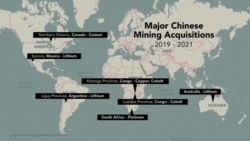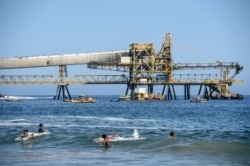New clean energy technologies like solar power and electric vehicles are expected to remake the global energy industry. Trillions of dollars used to drill and ship oil and gas will instead be spent finding and processing the specialized minerals used to make high-tech gear including advanced electric generators and powerful, compact batteries.
Energy analysts say this will challenge the United States, which will likely need to import vastly more minerals like cobalt, lithium and aluminum, at the same time that China has increased its control over the supply of some key resources.
A VOA examination of U.S. government data shows how China has become the main supplier for some of the most important raw materials that Western countries import, giving Beijing leverage over the materials that go into everything from advanced fighter jets to solar panels.
Not only has Beijing bought up some of the world’s biggest mines for these minerals, the country also has invested heavily in the processing facilities that refine the raw materials into industrially-useful products, strengthening Beijing’s position in global supply chains.
Beijing has already given the world reason to worry about its reliability as a global supplier. In 2011, it used its position as the top global supplier of rare earth metals to cut exports, driving up prices. China’s critics say Beijing’s dominant position in so-called “critical minerals” gives them similar leverage.
35 critical minerals
The United States has designated 35 mineral commodities that Washington says are critical to the country’s economic and national security.
The “critical minerals” list includes common elements such as aluminum, tin and magnesium, as well as more specialized materials like rare earths and vanadium.
Based on an analysis of statistics published by the U.S. Geological Survey, VOA determined that China holds a dominant position supplying 21 of the 35 critical minerals. For these minerals, China is the biggest source of U.S. imports, or it has the world’s biggest deposits or is the largest producer.
The United States is looking at ways to boost domestic production for some of the materials, but for 14 of them, it must rely totally on foreign imports, most of which involve China.
Arsenic, which is used in a wide range of electronics, is one example. The United States imports some 91% of its supply from China.
Cesium, used in a wide range of manufacturing, is another. There are only three pegmatite mines in the world that can produce cesium. Until 2019, the U.S. relied entirely on a Canadian mine for cesium. But that year the mine’s U.S. owners sold it to China's Sinomine Resource Group. Now China controls all three of the world’s cesium mines, according to OilPrice.com, a leading energy news website.
"We're so obsessed with looking at rare earths, that we're missing 20 other commodities that are equally important," James Kennedy, a consultant to the U.S. government and president of ThREE Consulting (Thorium & Rare Earth Elements), told VOA.
Jane Nakano, a senior fellow at the Center for Strategic and International Studies, said traditionally officials and specialists focused on how dependent countries had become on China for rare earths. Now, she tells VOA that concerns are shifting to the larger category of Critical Minerals.
"Looking at President Biden's executive order that came out on February 24 looking at the supply chain security, that does focus on critical minerals, including rare earth," she said.
Nakano, the author of a recent study titled "The Geopolitics of Critical Minerals Supply Chains," noted that government studies are now looking at the entire range of critical minerals, not just rare earth.
Chinese dominance in U.S. allies' supply chains
Other Western countries have different lists of minerals considered critical to their economies. Among the lists of Australia, U.K. and Canada, rare earth minerals account for only one of the 24, 41 and 31 critical minerals, respectively. The European Union classifies light and heavy rare earths as two separate critical elements on its 30 Critical Raw Materials (CRM) list.
A study published last year by the European Commission’s Joint Research Center, a science and technology service agency, found that the production of a Rafale fighter aircraft requires a total of 16 CRMs, of which only three are rare earth elements.
Although each country makes up its own list of “critical minerals” based on its strategic needs, China is a dominant supplier in all of the lists.
In the EU’s list, China is the largest source of imports for 10 minerals. Among the 24 critical minerals identified by the Australian government in its Critical Minerals Prospectus 2020 report, China is listed as the largest producer of 11 of them. In the U.K.'s Risk List, China is the leading producer of 23 minerals.
Similar findings were reported by Chinese researchers as well. A study published by China Geological Survey stated that "after combing through the list of Critical Minerals in the United States, the European Union, the United Kingdom and other countries, it can be seen that half or more of the country's main producing countries and main sources of imports are our country."
The 2019 report said that of the 35 key minerals in the U.S., the largest supplier of 13 CMs is China, and China is also the largest producer of 19 CMs.
This story originated in VOA's Mandarin Service.










